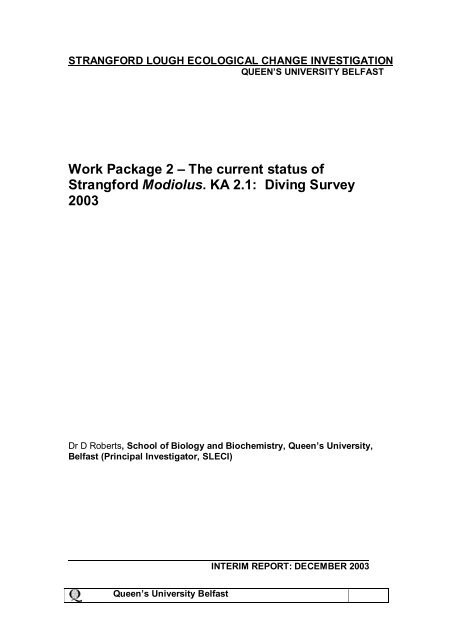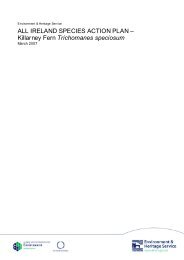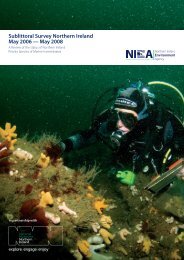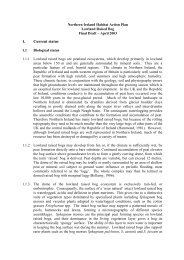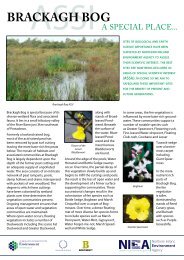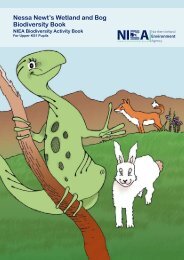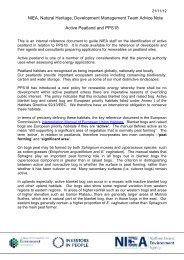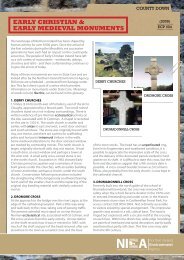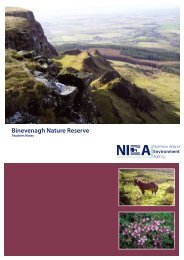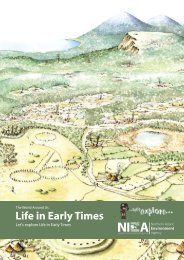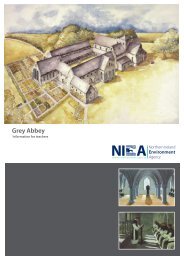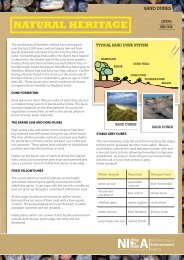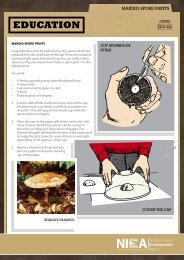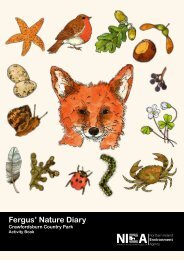Work Package 2 - Department of the Environment
Work Package 2 - Department of the Environment
Work Package 2 - Department of the Environment
You also want an ePaper? Increase the reach of your titles
YUMPU automatically turns print PDFs into web optimized ePapers that Google loves.
STRANGFORD LOUGH ECOLOGICAL CHANGE INVESTIGATION<br />
QUEEN’S UNIVERSITY BELFAST<br />
<strong>Work</strong> <strong>Package</strong> 2 – The current status <strong>of</strong><br />
Strangford Modiolus. KA 2.1: Diving Survey<br />
2003<br />
Dr D Roberts, School <strong>of</strong> Biology and Biochemistry, Queen’s University,<br />
Belfast (Principal Investigator, SLECI)<br />
Queen’s University Belfast<br />
INTERIM REPORT: DECEMBER 2003
Executive Summary<br />
Strangford Lough is currently on <strong>the</strong> UK list for designation as a Special Area<br />
<strong>of</strong> Conservation (SAC) under <strong>the</strong> EC Habitats Directive (92/43/EEC). A major<br />
feature for this candidacy is <strong>the</strong> sublittoral Modiolus modiolus biogenic reefs.<br />
Government <strong>Department</strong>s/Agencies and non-government organisations<br />
(NGOs) have expressed concern about <strong>the</strong> state <strong>of</strong> <strong>the</strong>se reefs (EHS, 2002).<br />
The Strangford Lough Ecological Change Investigation (SLECI),<br />
commissioned by <strong>Environment</strong> & Heritage Service, aims to identify <strong>the</strong> current<br />
conservation status <strong>of</strong> <strong>the</strong> Lough and any factors which may have contributed<br />
to change. This investigation involves assessing possible current/historical<br />
impacts <strong>of</strong> fishing or aquaculture, boating, change in climate, pollution,<br />
dredging and shore works, algal blooms, diseases and parasites, and alien<br />
species on <strong>the</strong> ecology <strong>of</strong> <strong>the</strong> Lough.<br />
All biological field-work as planned in <strong>the</strong> original tender has been completed.<br />
A total <strong>of</strong> 86 dive sites have been surveyed, some with repeat dives. Eighteen<br />
intertidal sites have been surveyed. In both sets <strong>of</strong> surveys differences have<br />
been noted between <strong>the</strong> present and earlier surveys. Analysis <strong>of</strong> biological<br />
samples is nearly complete and data analysis, including analysis <strong>of</strong> over 30<br />
hours <strong>of</strong> video records, has started.<br />
The investigation is scheduled to be completed by December 2003 and will<br />
report in full at <strong>the</strong> end <strong>of</strong> February 2004. However, <strong>the</strong> terms <strong>of</strong> <strong>the</strong> contract<br />
allow for publication <strong>of</strong> parts <strong>of</strong> <strong>the</strong> investigation as <strong>the</strong>y are completed. This is<br />
a position report from work package 2 which is to investigate <strong>the</strong> current<br />
extent and condition <strong>of</strong> <strong>the</strong> Modiolus communities in <strong>the</strong> Lough. This involved<br />
a comprehensive diving survey undertaken in July and August and additional<br />
dive surveys in October this year.<br />
Detailed analysis <strong>of</strong> <strong>the</strong> underwater video footage and quadrat samples is not<br />
yet complete, but <strong>the</strong> important issue is that this part <strong>of</strong> <strong>the</strong> study already<br />
provides evidence <strong>of</strong> <strong>the</strong> extent <strong>of</strong> change in <strong>the</strong> Modiolus communities which<br />
supports earlier studies. The Biogenic Modiolus reef feature in Strangford<br />
Lough is no longer in ‘Favourable Conservation Status’ as compared to <strong>the</strong><br />
mid 1980’s and urgent management action to protect <strong>the</strong> few remaining<br />
Modiolus beds within Strangford Lough should be considered by <strong>the</strong><br />
competent authorities.<br />
SLECI INTERIM REPORT: DECEMBER 2003 2
Conclusions<br />
1. The present study demonstrates that Modiolus reefs are no longer in<br />
‘Favorable Conservation Status’ (The condition in which <strong>the</strong> habitat or<br />
species is capable <strong>of</strong> sustaining itself on a long-term basis [Anon,<br />
1997]) in Strangford Lough.<br />
2. There was a 3.7km 2 reduction in clumped Modiolus communities<br />
between 1993 and 2000.<br />
3. Comparison <strong>of</strong> <strong>the</strong> current with earlier diving surveys confirms this<br />
decline in Modiolus communities and suggests it is continuing.<br />
4. There is no evidence to suggest recovery <strong>of</strong> Modiolus communities in<br />
Strangford Lough has been taking place since <strong>the</strong> conservation<br />
measures, involving legislation to manage fishing activity, were<br />
introduced in 1993 to protect <strong>the</strong>m.<br />
5. There is <strong>the</strong>refore an urgency to protect remaining Modiolus<br />
communities in Strangford Lough.<br />
6. More detailed mapping, to determine <strong>the</strong> precise extent and condition<br />
<strong>of</strong> <strong>the</strong> Modiolus communities using techniques developed by SLECI<br />
and elsewhere are needed after <strong>the</strong> final SLECI report is completed.<br />
7. The use <strong>of</strong> mobile bottom fishing gear poses <strong>the</strong> most immediate threat<br />
to <strong>the</strong> few remaining clumped Modiolus communities within <strong>the</strong><br />
confines <strong>of</strong> Strangford Lough cSAC. Notwithstanding that Modiolus<br />
recruitment is still occurring in Strangford Lough, <strong>the</strong> continued use <strong>of</strong><br />
mobile bottom fishing gear is likely to hinder natural recovery.<br />
Fishermen trying to develop alternative, sustainable practices should<br />
<strong>the</strong>refore be encouraged.<br />
8. To build on <strong>the</strong> facts that Modiolus populations are similar in structure<br />
to samples taken in <strong>the</strong> 1970s and recruitment appears to be still<br />
occurring, a programme for <strong>the</strong> restoration <strong>of</strong> Modiolus biogenic reefs<br />
in Strangford Lough should be considered; this should be underpinned<br />
using state-<strong>of</strong>-<strong>the</strong>-art techniques to monitor physiological and shell<br />
indicators <strong>of</strong> stress in Modiolus to ensure success.<br />
SLECI INTERIM REPORT: DECEMBER 2003 3
Introduction<br />
Modiolus modiolus communities form biogenic (i.e. produced by <strong>the</strong> actions<br />
<strong>of</strong> living organisms) reefs that are a major selection feature <strong>of</strong> interest for <strong>the</strong><br />
Strangford Lough SAC (SAC Annex 1 selection feature ‘Reefs’). These beds<br />
have been documented in <strong>the</strong> Lough since <strong>the</strong> mid 1800’s (Dickie,1857). In<br />
<strong>the</strong> 1970s <strong>the</strong> Modiolus beds were known to be extensive (Erwin, 1978) and ‘<br />
<strong>the</strong> bed situated amongst <strong>the</strong> numerous small islands <strong>of</strong>f Killyleagh at depths<br />
<strong>of</strong> 6 to 9 fathoms which were sampled regularly during this investigation,<br />
appears to be well over one square mile in extent’ (Seed & Brown, 1977).<br />
The full extent <strong>of</strong> <strong>the</strong> beds was not reported in detail until <strong>the</strong> early 1990s by<br />
which time certain areas, particularly those occupied by <strong>the</strong> M. modiolus/<br />
Chlamys varia community [JNCC biotope classification SCR.ModCvar.], were<br />
heavily impacted by trawling for queen scallops, (Service & Magorrian, 1997).<br />
It is now well established that trawling and dredging can damage biogenic<br />
reefs, seabed communities and emergent epifauna (see for example: Watling<br />
& Norse, 1998; Cranfield et al., 2003). As a result <strong>of</strong> recommendations by <strong>the</strong><br />
<strong>the</strong>n <strong>Department</strong> <strong>of</strong> Agriculture for Nor<strong>the</strong>rn Ireland (DANI now <strong>Department</strong> <strong>of</strong><br />
Agriculture and Rural Development [DARD]), a number <strong>of</strong> legislative<br />
measures were introduced in 1993 to manage fishing activity (Service &<br />
Magorrian, 1997).<br />
The most recent broadscale acoustic survey, prior to SLECI, reported a<br />
3.7km 2 reduction in area <strong>of</strong> clumped Modiolus between 1993 and 2000<br />
(Mitchell et al. 2002). A repeat acoustic survey was conducted in 2003 and<br />
will, following analysis and ground-truthing, be reported at a later date as part<br />
<strong>of</strong> <strong>the</strong> present investigation.<br />
One <strong>of</strong> <strong>the</strong> main aims <strong>of</strong> <strong>the</strong> current survey is to ascertain <strong>the</strong> current extent<br />
and condition <strong>of</strong> Modiolus reefs as compared to diving surveys conducted by<br />
<strong>the</strong> Ulster Museum during <strong>the</strong> 1970’s and 80’s.<br />
Strangford Lough can be divided into two main basins north and south <strong>of</strong> Long<br />
Sheelah (Appendix 1). The water in <strong>the</strong> sou<strong>the</strong>rn basin mixes quite freely with<br />
<strong>the</strong> Irish Sea, whilst <strong>the</strong> water in <strong>the</strong> nor<strong>the</strong>rn basin is retained within <strong>the</strong> lough<br />
for longer periods (Boyd, 1973).<br />
Modiolus beds in <strong>the</strong> North Basin are characterised by Modiolus modiolus<br />
co-dominant with Chlamys varia with abundant Queen scallops (Aequipecten<br />
opercularis) and occur between 10m and 35m depth. This community was<br />
described as a distinct biotope in <strong>the</strong> 1996 JNCC biotope classification with<br />
coding SCR.ModCvar. The biotope is only known within Strangford Lough<br />
and possibly Loch Creran in SW Scotland. It may represent a fine balance <strong>of</strong><br />
climatic conditions between suitability for Modiolus modiolus which has a<br />
predominantly cold-water distribution and Chlamys varia which has a<br />
SLECI INTERIM REPORT: DECEMBER 2003 4
predominantly temperate-water distribution. The large numbers <strong>of</strong> queen<br />
scallops (queenies), were formerly <strong>the</strong> basis <strong>of</strong> a commercial fishery in<br />
Strangford Lough.<br />
Modiolus beds in <strong>the</strong> South Basin have few Chlamys or Aequipecten but<br />
more hydroids and brittlestars (biotope code: SCR.ModHAs) and are less<br />
diverse than <strong>the</strong> Modiolus/Chlamys biotope. They have few Chlamys or<br />
Aequipecten and so have not been subjected to trawling for queenies,<br />
although <strong>the</strong>y are in <strong>the</strong> dredging zone for King scallops. Beds like <strong>the</strong>se are<br />
also found on <strong>the</strong> coast <strong>of</strong> <strong>the</strong> Ards peninsula and o<strong>the</strong>r places outside<br />
Strangford Lough.<br />
Both types <strong>of</strong> reefs are a major feature <strong>of</strong> <strong>the</strong> Lough justifying its status as a<br />
candidate Special Area <strong>of</strong> Conservation (cSAC) and as a Marine Nature<br />
Reserve.<br />
In <strong>the</strong>ir 1997 paper, Service and Magorrian indicated that management <strong>of</strong><br />
fishing activity in <strong>the</strong> Lough, toge<strong>the</strong>r with <strong>the</strong> establishment <strong>of</strong> Strangford<br />
Lough as a Marine nature reserve, would allow future assessment <strong>of</strong> recovery<br />
<strong>of</strong> areas formerly impacted by mobile bottom gear.<br />
This preliminary report provides <strong>the</strong> most recent information on <strong>the</strong> current<br />
extent and condition <strong>of</strong> <strong>the</strong> Modiolus communities in <strong>the</strong> Lough based on a<br />
comprehensive diving survey undertaken in July and August and additional<br />
dive surveys in October this year. The findings presented here will be<br />
integrated in <strong>the</strong> final report with detailed RoxAnn surveys <strong>of</strong> <strong>the</strong> Lough<br />
undertaken this year and with o<strong>the</strong>r surveys carried out since <strong>the</strong> mid 1990s<br />
by DARD.<br />
Methods<br />
Dive Survey<br />
Divers working in pairs carried out direct observations and sampling <strong>of</strong> <strong>the</strong><br />
seabed. A total <strong>of</strong> 86 dive sites (Appendix 2) were visited during July August<br />
and October 2003. Some <strong>of</strong> <strong>the</strong>se were chosen to be as close as possible to<br />
<strong>the</strong> Modiolus dominated sites found in <strong>the</strong> earlier Nor<strong>the</strong>rn Ireland Sublittoral<br />
Survey/Ulster Museum between 1975 and 1985. O<strong>the</strong>r dive sites were in<br />
different habitats and were chosen to investigate possible changes in <strong>the</strong>se<br />
o<strong>the</strong>r habitats.<br />
Modiolus habitat condition was assessed at a number <strong>of</strong> sites using 100m<br />
transect lines marked at 1m intervals using <strong>the</strong> method reported by Brown<br />
(1989). In <strong>the</strong> present study, observations were supported by underwater<br />
video footage shot on 3-chip digital video cameras in underwater housings.<br />
Processing <strong>of</strong> samples and video is still in progress.<br />
Population and community studies<br />
Modiolus modiolus was collected from three areas identified as having<br />
relatively dense areas <strong>of</strong> Modiolus biotopes:<br />
SLECI INTERIM REPORT: DECEMBER 2003 5
1. North <strong>of</strong> <strong>the</strong> Long Sheelah,<br />
2. The raised area to <strong>the</strong> west <strong>of</strong> Round Island<br />
3. The area known as <strong>the</strong> Black Rock beds.<br />
In <strong>the</strong>se areas, 0.25m 2 quadrats were taken at random points along a 100m<br />
transect laid on <strong>the</strong> seabed. The samples were transferred into mesh onion<br />
bags, attached to a lifting bag and raised to <strong>the</strong> surface boat where <strong>the</strong>y were<br />
placed in buckets <strong>of</strong> seawater. In <strong>the</strong> laboratory <strong>the</strong> samples were washed<br />
through a 1mm sieve and live Modiolus were removed from <strong>the</strong> sample. Shell<br />
length, height and width were measured to <strong>the</strong> nearest 0.1mm using callipers.<br />
The Modiolus were <strong>the</strong>n placed in holding tanks for subsequent experiments.<br />
The remainder <strong>of</strong> <strong>the</strong> quadrat samples were preserved in 70% alcohol for<br />
fur<strong>the</strong>r community analysis.<br />
SLECI INTERIM REPORT: DECEMBER 2003 6
Results<br />
Dive survey<br />
Modiolus beds in Strangford Lough as reported by Ulster Museum divers<br />
between 1975 and 1985 are shown in Appendix 1. The beds were<br />
widespread below <strong>the</strong> 10 m contour and largely undisturbed during this<br />
period; beds were characterised by biotope SCR.ModCvar. (Figures 1a,b) in<br />
<strong>the</strong> north basin, where <strong>the</strong> majority <strong>of</strong> dive sites had Modiolus, and biotope<br />
SCR.ModHAs. (Figutre 1c,d) in <strong>the</strong> south basin.<br />
Current situation<br />
In <strong>the</strong> present study (2003) intact, clumped Modiolus beds were located at<br />
only six out <strong>of</strong> a total <strong>of</strong> 44 field-sampling sites in a small area in <strong>the</strong> North<br />
Basin and eight out <strong>of</strong> a total <strong>of</strong> 41 sites in four widely spaced areas in <strong>the</strong><br />
South Basin (Appendix 2).<br />
North Basin [SCR.ModCvar]<br />
In <strong>the</strong> North Basin <strong>the</strong> Modiolus beds appear to be very much reduced in<br />
extent. Only six field-sampling sites in a small area in <strong>the</strong> North Basin are <strong>the</strong><br />
classic Modiolus with Chlamys community or biotope (SCR.ModCvar)<br />
(Figures 1a,b). These are located at <strong>the</strong> side <strong>of</strong> this basin and <strong>the</strong>se may no<br />
longer be in pristine condition (dive sites 11, 36, 37 48, 63 and 77 in Appendix<br />
2) as indicated by <strong>the</strong> decline in some key species <strong>of</strong> sponges and<br />
echinoderms. By contrast, <strong>the</strong> majority <strong>of</strong> sites in <strong>the</strong> north basin surveyed by<br />
divers between 1975 and 1985, had clumped Modiolus communities.<br />
At <strong>the</strong> centre <strong>of</strong> <strong>the</strong> North Basin, which was formerly <strong>the</strong> main area for <strong>the</strong><br />
classic Modiolus with Chlamys biotope but was also zoned for trawling <strong>of</strong><br />
queenies, no clumped Modiolus remain at any site visited; this area now<br />
has extensive areas <strong>of</strong> dead shell with occasional live Modiolus individuals.<br />
(Figures 1e,f). Very few queen scallops were observed at any site within <strong>the</strong><br />
North Basin.<br />
South Basin [SCR.ModHAs]<br />
Modiolus beds (biotope SCR.ModHAs) were historically present in several<br />
areas in <strong>the</strong> south basin, East <strong>of</strong> Black Rock, East <strong>of</strong> Taggart Island and at<br />
various places between <strong>the</strong> Limestone Rock and <strong>the</strong> Long Sheelah. Three <strong>of</strong><br />
<strong>the</strong>se areas were surveyed during <strong>the</strong> present study.<br />
Black Rock beds<br />
They are currently mostly intact, though areas adjacent to <strong>the</strong>m are in poor<br />
condition, with many Modiolus almost completely buried in muddy sediment<br />
which appears to be recently accumulated.<br />
Area to west <strong>of</strong> Round Island<br />
This area had not been surveyed previously by diving. It was found to have<br />
clumped Modiolus beds from 10m to 30m depth. The beds were more<br />
disrupted in deeper water but o<strong>the</strong>rwise showed little sign <strong>of</strong> disturbance.<br />
SLECI INTERIM REPORT: DECEMBER 2003 7
Channel East <strong>of</strong> Selk Rock, Taggart Island<br />
The bottom here was reported to have a dense bed <strong>of</strong> Modiolus modiolus in<br />
1976 by Ulster Museum divers. It now consists <strong>of</strong> mostly dead shells, with a<br />
scattering <strong>of</strong> live Modiolus. At this site areas <strong>of</strong> dense dead shell alternated<br />
with bare mud.<br />
SLECI INTERIM REPORT: DECEMBER 2003 8
a) Modiolus clump in intact bed -<br />
Modiolus/Chlamys biotope, Ophiothrix<br />
brittlestars<br />
c) Modiolus clump from south basin,<br />
with hydroids and Antedon<br />
e) Area <strong>of</strong> dead Modiolus shell - main channel,<br />
North basin<br />
Figure 1. Stills images from video footage<br />
b) Modiolus/Chlamys clump, Chlamys varia<br />
feeding and showing mantles<br />
d) Modiolus showing “clean” appearance <strong>of</strong><br />
south basin mussels<br />
f) Area <strong>of</strong> mud with shell, adjacent to Fig. 2e.<br />
SLECI INTERIM REPORT: DECEMBER 2003 9
Preliminary Population studies<br />
Data from <strong>the</strong> current population census were grouped by area and sorted<br />
into 5mm size classes. Size frequency histograms were constructed for <strong>the</strong>se<br />
three areas and compared to data taken by Brown between 1973 and 1976<br />
(Brown, 1976) (Figure 2).<br />
20 . 0<br />
18 . 0<br />
16 . 0<br />
14 . 0 n = 1006<br />
25.0<br />
20.0<br />
n = 54<br />
%<br />
12 . 0<br />
10 . 0<br />
8.0<br />
15.0 %<br />
%<br />
6.0<br />
4.0<br />
2.0<br />
0.0<br />
30 .0<br />
25 .0<br />
20 .0<br />
15 .0<br />
10 .0<br />
5.0<br />
0.0<br />
0 to 5<br />
0-4.9<br />
5 to 10<br />
5.0-9.9<br />
a) South Basin (Brown 1974)<br />
10 to 15<br />
15 to 20<br />
20 to 25<br />
25 to 30<br />
30 to 35<br />
35 to 40<br />
40 to 45<br />
45 to 50<br />
50 to 55<br />
55 to 60<br />
60 to 65<br />
Size Class (mm)<br />
c) Area B South Basin<br />
(Present study 2003)<br />
n = 136<br />
10.0-14.9<br />
15.0-19.9<br />
20.0-24.9<br />
25.0-29.9<br />
30.0-34.9<br />
35.0-39.9<br />
40.0-44.9<br />
45.0-49.9<br />
50.0-54.9<br />
55.0-59.9<br />
65 to 70<br />
60.0-64.9<br />
70 to 75<br />
65.0-69.9<br />
Size Category (mm)<br />
75 to 80<br />
70.0-74.9<br />
80 to 85<br />
75.0-79.9<br />
85 to 90<br />
80.0-84.9<br />
90 to 95<br />
85.0-89.9<br />
95 to 100<br />
90.0-94.9<br />
100 to 105<br />
95.0-99.9<br />
105 to 110<br />
100.0-1 04.9<br />
110 to 115<br />
105.0-1 09.9<br />
110.0-1 14.9<br />
115.0-1 19.9<br />
SLECI INTERIM REPORT: DECEMBER 2003 10<br />
30.0<br />
10.0<br />
5.0<br />
0.0<br />
30.0<br />
25.0<br />
20.0<br />
15.0<br />
10.0<br />
0-4.9<br />
5. 0<br />
0. 0<br />
0-4.9<br />
5.0-9.9<br />
5. 0- 9. 9<br />
10.0-1 4.9<br />
10.0-14.9<br />
15.0-1 9.9<br />
15.0-19.9<br />
20.0-2 4.9<br />
20.0-24.9<br />
25.0-2 9.9<br />
25.0-29.9<br />
30.0-3 4.9<br />
30.0-34.9<br />
35.0-3 9.9<br />
35.0-39.9<br />
40.0-4 4.9<br />
40.0-44.9<br />
45.0-4 9.9<br />
45.0-49.9<br />
50.0-5 4.9<br />
55.0-5 9.9<br />
60.0-6 4.9<br />
65.0-6 9.9<br />
Size Category (mm)<br />
50.0-54.9<br />
55.0-59.9<br />
60.0-64.9<br />
65.0-69.9<br />
Size Category (mm)<br />
Figure 2. Comparison <strong>of</strong> <strong>the</strong> population pr<strong>of</strong>iles <strong>of</strong> Modiolus modiolus<br />
(% size frequencies) in Strangford Lough for 1974,and 2003 (Areas A, B<br />
& C).<br />
Earlier samples (Figure 2a) showed a skewed population modality<br />
characteristic <strong>of</strong> populations dominated by older individuals and typical <strong>of</strong><br />
many Modiolus populations (see e.g. Brown & Seed, 1978; Rees et al., 2001).<br />
Population samples taken during <strong>the</strong> present study (Figure 2b-d) were similar<br />
in structure to samples taken in <strong>the</strong> 1970s and showed little evidence <strong>of</strong><br />
change with <strong>the</strong> possible exception <strong>of</strong> <strong>the</strong> sample from Area A which showed<br />
an absence <strong>of</strong> individuals from <strong>the</strong> size classes from 15.0mm to 44.9mm.<br />
However, <strong>the</strong> sample from this site was small; in addition at this site and <strong>the</strong><br />
o<strong>the</strong>r sites <strong>the</strong>re are individuals as small as 5mm which suggests that<br />
recruitment is still occurring.<br />
%<br />
b) Area A, South Basin<br />
(Present Study 2003)<br />
d) Area C North Basin<br />
(Present study 2003)<br />
n = 218<br />
70.0-7 4.9<br />
70.0-74.9<br />
75.0-7 9.9<br />
75.0-79.9<br />
80.0-8 4.9<br />
80.0-84.9<br />
85.0-8 9.9<br />
85.0-89.9<br />
90.0-94.9<br />
90.0-9 4.9<br />
95.0-99.9<br />
95.0-9 9.9<br />
100.0-104.9<br />
100.0-1 04.9<br />
105.0-109.9<br />
105.0-1 09.9<br />
110.0-114.9<br />
110.0-1 14.9<br />
115.0-119.9<br />
115.0-1 19.9
Summary <strong>of</strong> findings<br />
A full discussion <strong>of</strong> <strong>the</strong> findings will be provided in <strong>the</strong> final report at <strong>the</strong> end <strong>of</strong><br />
<strong>the</strong> investigation scheduled for <strong>the</strong> end <strong>of</strong> February 2004. The intention <strong>of</strong> this<br />
interim report is to alert EHS to <strong>the</strong> current status <strong>of</strong> <strong>the</strong> Modiolus reefs based<br />
on findings <strong>of</strong> <strong>the</strong> dive survey.<br />
1. In <strong>the</strong> 1970s & 80s Modiolus beds were known to be extensive in<br />
Strangford Lough (Seed & Brown, 1977; Erwin, 1978, Erwin et al,<br />
1990).<br />
2. The full extent <strong>of</strong> <strong>the</strong> beds was not reported in detail until <strong>the</strong> early<br />
1990s by which time certain areas, particularly those occupied by <strong>the</strong><br />
M. modiolus/ Chlamys varia community, were heavily impacted by<br />
mobile fishing gear (Service & Magorrian, 1997).<br />
3. Trawling and dredging are known to damage biogenic reefs and<br />
seabed communities (Watling & Norse, 1998; Cranfield et al. 2003).<br />
Within Strangford Lough trawling has been reported as removing<br />
emergent epifauna (Service & Magorrian, 1997).<br />
4. As a result <strong>of</strong> recommendations by <strong>the</strong> <strong>the</strong>n <strong>Department</strong> <strong>of</strong> Agriculture<br />
for Nor<strong>the</strong>rn Ireland (DANI now <strong>Department</strong> <strong>of</strong> Agriculture and Rural<br />
Development [DARD]), a number <strong>of</strong> legislative measures were<br />
introduced in 1993 to manage fishing activity.<br />
5. The most recent survey, prior to SLECI, reported a 3.7km 2 reduction in<br />
area <strong>of</strong> clumped Modiolus between 1993 and 2000 (Mitchell et al.<br />
2002).<br />
6. Comparison <strong>of</strong> <strong>the</strong> current with earlier diving surveys confirms <strong>the</strong><br />
decline in:<br />
• North basin Modiolus communities (SCR.ModCvar.) which are now<br />
very much reduced in extent and may no longer be in pristine condition<br />
• South basin Modiolus communities (SCR.ModHAs.).Although <strong>the</strong>se<br />
are more widely distributed than communities in <strong>the</strong> North basin and<br />
several beds remain, a number <strong>of</strong> <strong>the</strong>se, show greater or lesser signs<br />
<strong>of</strong> disruption.<br />
7. In sites where it was possible to collect population samples, population<br />
structure showed little differences from samples taken in <strong>the</strong> 1970s as<br />
a wide range <strong>of</strong> sizes were present and, <strong>the</strong>re were individuals as small<br />
as 5mm which suggests that recruitment is still occurring.<br />
SLECI INTERIM REPORT: DECEMBER 2003 11
Conclusions<br />
1. The present study demonstrates that Modiolus reefs are no longer in<br />
‘Favorable Conservation Status’ (The condition in which <strong>the</strong> habitat or<br />
species is capable <strong>of</strong> sustaining itself on a long-term basis [Anon,<br />
1997]) in Strangford Lough.<br />
2. There was a 3.7km 2 reduction in clumped Modiolus communities<br />
between 1993 and 2000.<br />
3. Comparison <strong>of</strong> <strong>the</strong> current with earlier diving surveys confirms this<br />
decline in Modiolus communities and suggests it is continuing.<br />
4. There is no evidence to suggest recovery <strong>of</strong> Modiolus communities in<br />
Strangford Lough has been taking place since <strong>the</strong> conservation<br />
measures, involving legislation to manage fishing activity, were<br />
introduced in 1993 to protect <strong>the</strong>m.<br />
5. There is <strong>the</strong>refore an urgency to protect remaining Modiolus<br />
communities in Strangford Lough.<br />
6. More detailed mapping, to determine <strong>the</strong> precise extent and condition<br />
<strong>of</strong> <strong>the</strong> Modiolus communities using techniques developed by SLECI<br />
and elsewhere are needed after <strong>the</strong> final SLECI report is completed.<br />
7. The use <strong>of</strong> mobile bottom fishing gear poses <strong>the</strong> most immediate threat<br />
to <strong>the</strong> few remaining clumped Modiolus communities within <strong>the</strong><br />
confines <strong>of</strong> Strangford Lough cSAC Notwithstanding that Modiolus<br />
recruitment is still occurring in Strangford Lough, <strong>the</strong> continued use <strong>of</strong><br />
mobile bottom fishing gear is likely to hinder natural recovery.<br />
Fishermen trying to develop sustainable practices should <strong>the</strong>refore be<br />
encouraged.<br />
8. To build on <strong>the</strong> facts that Modiolus populations are similar in structure<br />
to samples taken in <strong>the</strong> 1970s and recruitment appears to be still<br />
occurring, a programme for <strong>the</strong> restoration <strong>of</strong> Modiolus biogenic reefs<br />
in Strangford Lough should be considered; this should be underpinned<br />
using state-<strong>of</strong>-<strong>the</strong>-art techniques to monitor physiological and shell<br />
indicators <strong>of</strong> stress in Modiolus to ensure success.<br />
SLECI INTERIM REPORT: DECEMBER 2003 12
References<br />
Anon 1997. Natura 2000: European marine sites, an introduction to management.<br />
SNH, EN, EHS (DOE(NI)), JNCC, CCW. Perth, SNH,17pp.<br />
Boyd, R.J. 1973. The relation <strong>of</strong> <strong>the</strong> plankton to <strong>the</strong> physical, chemical and biological<br />
features <strong>of</strong> Strangford Lough, Co. Down. Proceedings <strong>of</strong> <strong>the</strong> Royal Irish Academy,<br />
73B, 317-353.<br />
Brown, R. A. 1976. The Ecology <strong>of</strong> Modiolus modiolus (L) and Cerastoderma<br />
(=Cardium) edule (L) in Strangford Lough, N. Ireland. PhD Thesis, Queen’s<br />
University <strong>of</strong> Belfast<br />
Brown, R.A., 1989. Bottom trawling in Strangford Lough: Problems and policies.<br />
North Sea Conference, Rotterdam.<br />
Brown, R.A. & Seed, R., 1978. Modiolus modiolus (L.) – an autecological study. In:<br />
Biology <strong>of</strong> Benthic Organisms. B.F. Keegan et al. eds. Pergammon Press, Oxford. pp<br />
93-100.<br />
Cranfield H.J., Manighetti, B., Mitchell K.P. & Hill A. 2003. Effects <strong>of</strong> oyster dredging<br />
on <strong>the</strong> distribution <strong>of</strong> bryozoan biogenic reefs and associated sediments in Foveaux<br />
Strait, sou<strong>the</strong>rn New Zealand. Continental Shelf Research 23, 1337-1357.<br />
Dickie, G., 1857. Report on <strong>the</strong> Marine Zoology <strong>of</strong> Strangford Lough. Report British.<br />
Association, 1857.<br />
EHS, 2002. Report on <strong>the</strong> Modiolus community in Strangford Lough: formal advice to<br />
<strong>the</strong> minister for <strong>the</strong> environment from <strong>Environment</strong> and Heritage Service. 9pp.<br />
Erwin, D. G. 1978. A diving survey <strong>of</strong> Strangford Lough: <strong>the</strong> benthic communities and<br />
<strong>the</strong>ir relation to substrate – a preliminary account. In: Biology <strong>of</strong> Benthic Organisms.<br />
B.F. Keegan et al. eds. Pergammon Press, Oxford. pp 215-224.<br />
Erwin, D.G., Picton. B.E., Connor, D.W., Howson, C.W., Gilleece, P. and Bogues,<br />
M.J. 1990. Inshore Marine Life <strong>of</strong> Nor<strong>the</strong>rn Ireland. A Report for <strong>the</strong> <strong>Department</strong> Of<br />
<strong>Environment</strong>- Nor<strong>the</strong>rn Ireland. Ulster Museum, HMSO, 148 pp.<br />
Mitchell, A., Wall, C & Service, M. 2002. Strangford Lough Broadscale subtidal<br />
habitat mapping project: Interim report. EHS. 22pp.<br />
Rees, E.I.S. 2001. Section 3.3. Introduction and history <strong>of</strong> work on <strong>the</strong> Pen Llyn<br />
Modiolus reef . In: The establishment <strong>of</strong> a programme <strong>of</strong> surveillance and monitoring<br />
for judging <strong>the</strong> condition and features <strong>of</strong> Pen Llyn a’r sarnau cSAC: 1. Progress to<br />
March 2001. W.G. Sanderson et al. eds. Bangor, CCW Contract Science Report No<br />
380 (U.K Marine SACs Project), 400pp.<br />
Seed, R. & Brown, R.A. 1977. A comparison <strong>of</strong> <strong>the</strong> reproductive cycles <strong>of</strong> Modiolus<br />
modiolus (L.) Cerastoderma (=Cardium) edule (L.) and Mytilus edulis L. in Strangford<br />
Lough, Nor<strong>the</strong>rn Ireland. Oecologia (Berl.) 30,173-188.<br />
SLECI INTERIM REPORT: DECEMBER 2003 13
Service, M & Magorrian, B.H. 1997. The extent and temporal variation <strong>of</strong> disturbance<br />
to epibenthic communities in strangford Lough, Nor<strong>the</strong>rn Ireland. Journal <strong>of</strong> <strong>the</strong><br />
Marine Biological Association, U.K. 77, 1151-1164.<br />
Watling, L. & Norse, A.E. 1998. Disturbance <strong>of</strong> <strong>the</strong> seabed by mobile fishing gear: A<br />
comparison with forest clear-cutting. Conservation Biology 12, 1180-1197.<br />
SLECI INTERIM REPORT: DECEMBER 2003 14
Appendix 1. Ulster Museum sites. Line illustrates approximate division <strong>of</strong><br />
north and south basins<br />
NISS & Ulster Museum divesite positions1975-85<br />
Legend<br />
1975-85 sites<br />
O<strong>the</strong>r communities<br />
Modiolus beds<br />
Sparse Modiolus<br />
Nephrops ground<br />
Coastline<br />
Islands<br />
10mContour<br />
SLECI INTERIM REPORT: DECEMBER 2003 15
Appendix 2 – SLECI dive-site details. Sites marked green have intact<br />
Modiolus/Chamys ,[SCR.ModCvar.], those marked blue have intact<br />
Modiolus/hydroids[SCR.ModHAs.]. N – North basin; S – South basin<br />
Field<br />
Site No<br />
DiveNo Description<br />
1 030702/03 S Bare muddy seabed with scattered shells<br />
2 030702/04 S Scattered dead Modiolus shell, some live Modiolus clumps partially buried in mud<br />
3 030703/01 N Scattered dead Modiolus shell<br />
4 030703/02 N Mud with dead shell, some Modiolus/Chlamys clumps<br />
5 030703/03 N Mud with dead shell, occasional boulder with lots <strong>of</strong> hydroids<br />
6 030703/04 N Fine mud, Sagartiogeton laceratus<br />
7 030704/01 S Boulders on gravel & sand, vast quantities <strong>of</strong> Ciona intestinalis<br />
8 030704/02 S Gravelly mud dead shell, cobbles<br />
9 030704/03 S Virgularia<br />
10 030704/04 S Gravelly mud dead shell, cobbles, Cerianthus, Virgularia<br />
11 030707/01 N Continuous live Modiolus modiolus<br />
12 030707/02 N Dead shell with Hydrallmania<br />
13 030707/03 N Mud with broken shell, large no's <strong>of</strong> Pandalus montagui<br />
14 030707/04 N Mud with dead shell, frequent Suberites carnosus<br />
15 030708/01 N Featureless mud very few Nephrops, Hydrallmania<br />
16 030708/02 S Scattered live Modiolus modiolus and broken dead shell<br />
17 030708/03 S Muddy Sand/ Amphiura<br />
18 030708/04 S Cobbles and coarse gravel Neopentadactyla<br />
19 030709/01 S Mud w. shell/Gravel becoming boulders covered with Ascidiella<br />
20 030709/02 S Gravel & cobbles with Ophiocomina and lots <strong>of</strong> hydriods<br />
21 030709/03 S Virgularia/ firm mud<br />
22 030709/04 S Virgularia<br />
23 030721/01 S Modiolus modiolus clumps covered with sediment<br />
24 030721/03 S Mud with Scattered broken shell & Alcyonium/Sagartia elegans<br />
25 030721/04 S Dense dead Modiolus shell<br />
26 030722/01 N Scattered dead Modiolus shell<br />
27 030722/02 N Scattered dead Modiolus shell<br />
28 030722/03 N Few live Modiolus/Chlamys becoming scattered dead Modiolus shell<br />
29 030722/04 N Scattered dead Modiolus shell <strong>the</strong>n Nephrops<br />
30 030722/05 N Cobbles, shell, lots <strong>of</strong> Ophiocomina<br />
31 030724/01 N Mud with dead shell<br />
32 030724/02 N Scattered Sagartia, lots <strong>of</strong> Epizoanthus, Mud with scattered broken shell<br />
33 030724/03 N Mud with dead shell<br />
34 030724/04 N Mud with dead shell, lots <strong>of</strong> Asterias in feeding clumps<br />
35 030725/01 N Shelly mud, large no's <strong>of</strong> Ostrea edulis and Pandulus montagui<br />
36 030725/02 & 3 N Continuous live Modiolus modiolus<br />
37 030728/01 & 02 N Continuous live Modiolus modiolus<br />
38 030728/03 N Oyster bed<br />
39 030729/01 N Scattered live <strong>the</strong>n dead Modiolus modiolus shell<br />
40 030729/02 N Scattered dead Modiolus shell<br />
41 030729/03 & 04 N Scattered dead Modiolus shell<br />
42 030730/01 S Nephrops bed/Sagartiogeton laceratus<br />
43 030730/02 S Nephrops bed<br />
44 030730/03 N Mud with dead shell<br />
45 030730/04 N Nephrops bed<br />
46 030731/01 N Featureless mud<br />
47 030731/02 N Mud with dead shell<br />
SLECI INTERIM REPORT: DECEMBER 2003 16
48 030731/03 N Continuous live Modiolus modiolus<br />
49 030731/04 S Modiolus modiolus clumps covered with sediment<br />
50 & 51 030801/01 & 02 S Modiolus modiolus clumps<br />
52 030801/03 S Ascidiella on boulders<br />
53 030801/04 S Nephrops bed/Sagartiogeton laceratus<br />
54 030811/01 S S<strong>of</strong>t mud w dead Modiolus shell<br />
55 030811/02 S Fine Sand/Mud w well mixed small fragments <strong>of</strong> shell. Clusters <strong>of</strong> large unbroken shell.<br />
56 030811/03 N S<strong>of</strong>t mud w anoxic layer 1" below surface<br />
57 030811/04 S Nephrops/Sagartiogeton laceratus<br />
58 030812/01 N Fine s<strong>of</strong>t mud littered w Modiolus, Venerupis & Chlamys shells<br />
59 030812/02 N Mud with dead shell<br />
60 030812/03 N Fine mud w well mixed small shell, some areas <strong>of</strong> intact shell, some mud w Goneplax<br />
burrows, In shallower water boulders on muddy substrate<br />
61 030812/04 N Dead shell, mud, Antedon, Hydrallmania, Thyone roscovita<br />
62 030812/05 N Fine mud, burrows<br />
63 030813/01,02,03,0<br />
4 N<br />
Continuous live Modiolus modiolus/ Some clumps<br />
64 030813/05 S Dead Maerl gravel w Laminarians in shallow water, Then covered w whole dead<br />
Modiolus shell<br />
65 030813/06 S Scattered dead Modiolus shell, scattered large living Modiolus<br />
66 030814/01 N Scattered dead modiolus shell<br />
67 030814/02 N Scattered dead modiolus shell, occasional boulders in deepest part <strong>of</strong> dive<br />
68 030814/03 N Nephrops bed<br />
69 030814/04,05,06 S Modiolus modiolus clumps<br />
70 030815/01 S Cobbles with Ophiocomina, Hydroids, Boulders and gravel<br />
71 030815/02 S Muddy substrate<br />
72 030815/03 S Scattered Modiolus modiolus clumps becoming mud with cobbles in deeper water<br />
73 030815/04 S Gravel, Urticina felina<br />
74 030815/05 S Boulders /cobbles/pebbles on gravelly sand covered w red algae<br />
75 031016/01 S M. modiolus clumps<br />
76 031016/02 S Thick dead Modiolus shell<br />
77 031016/03 N Continuous live M. modiolus<br />
78 031016/04 N Some clumped M. modiolus, much dead shell<br />
79 031016/05 S Dead M. modiolus shell, small boulders in shallow water<br />
80 031016/06 S Cobbles, pebbles, boulders covered in red algae, hydroids and sponges<br />
81 031017/01 S Boulders covered in hydroids and ascidians<br />
82 031017/02 S Medium density M. modiolus clumps<br />
83 031017/03 S NA<br />
84 031017/04 N Fine mud with lots <strong>of</strong> dead oyster shell, some dead M. modiolus<br />
85 031017/05 N Muddy sand<br />
86 031017/06 S NA<br />
SLECI INTERIM REPORT: DECEMBER 2003 17


